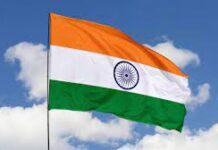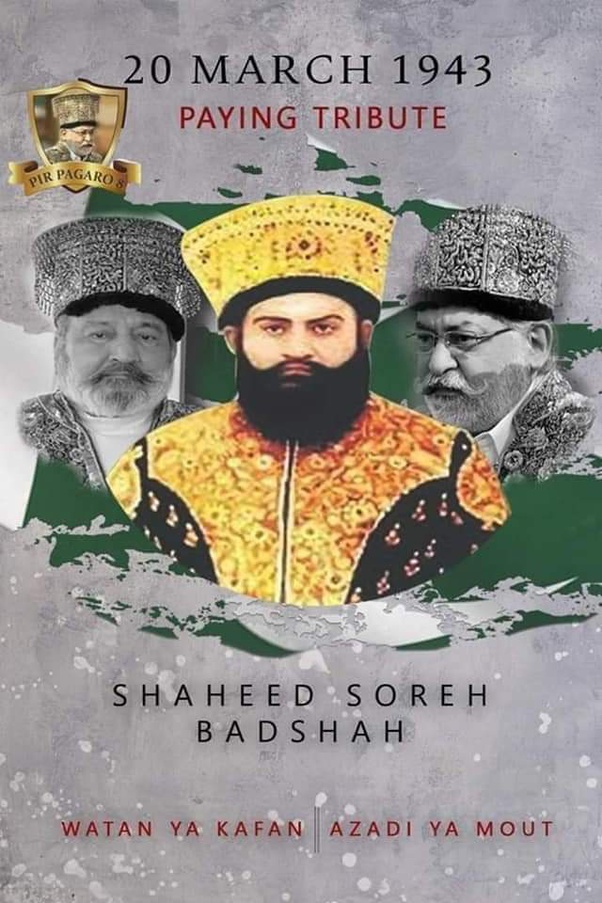By: Syed Tahir Rashdi
The 78th death anniversary of Pir Sabghatullah Shah Rashdi, better known as ‘Soreh Badhah’ (the Victorious King) was observed with traditional zeal across the country both by political followers and representatives of the Pakistan Muslim League-Functional (PML-F) and the followers of the Pir Pagara.
Tribute continue to pour in for the great Soreh Badshah because of the nature of his death. He was hung to death on March 20, 1943, over a military court verdict of the colonial regime. Even today, the spirit of his followers and supporters is alive, and on his death anniversary they remembered how neither lucrative offers nor repressive measures of the colonial power could distract him from his mission. Right before his hanging, artial law was imposed in those areas where the Pir was influential, and where the members of Hur Jamaat were residing. Soreh Badshah launched the freedom movement against the colonial powers at the age of 21, while the colonial rulers made ruthless efforts to crush the Hur uprising and killed hundreds of followers.
With a 108-year-long history, the Hur Movement in Sindh (1843-1951) is filled with thousands of valorous stories of mujahids (freedom fighters). The movement was initially kicked off by Sibghtullah Shah Badshah against the British colonialists, which was later on continued by his son Sibghtullah II Soreh Badshah, who chanted the famous slogan “Watan ya Kafan, Azadi ya Mout,” meaning “Land or a coffin, freedom or death” – no doubt uttered in his love for his motherland and national identity, and in remembrance of his great father.
Soreh Badshah as a leader vowed to strive to fulfill his dreams through a peaceful struggle. It is worth mentioning here that the Hur movement was launched by Sibghatullah Shah-I and it reached a crescendo under the Sibghatullah Shah-II known as Sooriah Badshah. Sibghatullah-I had sent his followers to Syed Ahmed Shaheed to fight alongside him against Sikhs. The fighters since then came to be called Hurs (free men).
When Sibghatullah-II became Pir Pagara in 1922, at the age of 12 years, he resumed the struggle against British rule. He believed that British officers’ behaviour towards Hur Jamat and the Sindhi people was unreasonable. He resented their behaviour and started to publicly support Indian independence. He organised a campaign against the colonial government and encouraged others to do the same. As a result, martial law was imposed to control the Hur movement. Pir Sahib established Gring Bungalow as his general headquarters. He recruited and trained followers to continue an armed struggle. Their slogans were, as mentioned earlier, “homeland or coffin” and “freedom or death”
The movement inflicted considerable damage on government infrastructure until Pir Pagara was arrested on Oct 24, 1941 and sent to jail. In 1942, prominent Hur leaders were arrested and the government bombed Pir Pagaras bungalow, Makhi forest and family shrine. Hurs were arrested in thousands along with their families and kept in concentration camps till 1952. Pagara and his followers fought against the colonial government for 108 years, from 1843 to 1951.
The “Lahore mail” railway train was derailed by Hurs on 16 May 1942. When Hurs attacked the army and police they raised the slogan of “Bhej Pagaara”. In an effort to rush the Hurs, their center Gring Bungalow was bombarded and destroyed on 26 May 1943. Pir Soreh Badshah was arrested on 24 October 1941 and imprisoned in Seoni in India.
The Hurs intensified their activities against the colonial government by attacking police stations, government buildings and railway stations as well as telephone and irrigation systems to paralyse society and to pressure the colonial government to release their spiritual leader.
Dargah Sharif and the bungalow in Pir Jo Goth were destroyed in 1943
In 1942 important leaders in Sindh Prant were arrested. Pir Sahib Pagara was brought from Seoni to Sindh in January 1943 and was detained in the central jail in Hyderabad. The Hurs established the Makhi forest as their base. The colonial government then began bombing Gring Bungalow, Makhi Forest and Dargah Sharif. They arrested thousands of Hur followers along with their families and kept them imprisoned until 1952.
The Hurs have a rich history of resistance. During the period of colonial rule (according to Voice of Sureh by Lutaf Mangrio and Nadeem Wagan), Pir Pagaro declared his community “Hur” (free). The colonial government made efforts to supress the movement, which resulted in an armed response from the Hurs. Ultimately the colonial government passed the Hurs Act, where all followers of the movement were declared criminals and army officers were allowed to shoot suspected members on sight. The Hurs continued their campaign even after the hanging of Pir Sahib, right up to the time of Pakistan’s independence.
Pir Pagaro Syed Sibghatullah Shah II was hanged on 20 March 1943 and the British left the South Asia four years later on 14 August 1947. After the end of British rule, Pir Pagaro’s two sons, who were in British custody in England, were released and came back to lead their community. Sindh was a province in the newly independent Pakistan. The sons of Sibghatullah Shah Shaheed, Pir Syed Shah Mardan Shah Rashdi-II alias Pir Syed Sikandar Ali Shah Rashidi and Pir Syed Nadir Ali Shah Rashidi were brought to Pakistan in December 1951 after long negotiations. The elder son, Pir Syed Shah Mardan Shah-II became the new Pir Pagara on 22 February 1952.
(The writer is a freelance writer based in Shahdadpur Sindh Pakistan. He is studying BSc Pakistan Studies at the University of Sindh and can be reached at [email protected].)























